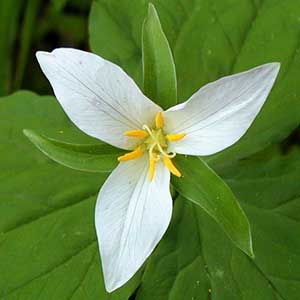Trillium ovatum
Trillium grandiflorum
Pacific trillium, trillium, western trillium, western wake-robin, western white trillium, white or western trillium, white trillium
great white trillium, large-flower trillium, trille grandiflore, white trillium, white wake-robin
semierect to horizontal, short, stout, praemorse.
short, thick, praemorse.
1–2, round, 2–5 dm, ± slender, glabrous.
(1–)2–3(–many), round in cross section, 1.5–3+ dm, thick, glabrous.
sessile, subsessile, or short-petiolate;
blade medium green, sometimes blotched and mottled, main veins prominent, ovate-rhombic, 7–12 × 5–20 cm, continuing to expand during anthesis, base rounded, apex acuminate.
sessile or subsessile (occasionally weakly cuneate basally);
blade dark green with maroon overtones early, ovate-rhombic, 12–20 × 8–15 cm, apex acuminate.
erect or nodding, odorless;
sepals spreading to horizontal, green, lanceolate to oblong-lanceolate, 15–50 × 6–20 mm, margins entire, apex acute;
petals erect-ascending, usually wide-spreading from base, exposing entire pistil, white or with pink or blush markings, lacking V-shaped markings, fading to rosy pink, purple, or dark red, veins not deeply engraved, ± linear to widely obovate, 1.5–7 ×1–4 cm, widest at or above middle, thin-textured, margins flat to undulate, apex acuminate;
stamens prominent, slightly recurved-spreading to straight, 10–18 mm;
filaments white, shorter than anthers, slender;
anthers yellow, 4–16 mm, slender, dehiscence latrorse-introrse;
ovary green or white, ovoid, 6-angled, 5–12 mm, attachment ± 3/4 ovary width;
stigmas recurved, barely connate basally, greenish white or white, linear, not lobed adaxially, 6–10 mm, uniformly thin;
pedicel erect to leaning, 2–6 cm.
outfacing, erect, odorless;
sepals spreading, flat, green, very rarely streaked with maroon-purple, lanceolate, 20–55 × 12–23 mm, margins entire, apex acuminate or acute;
petals erect basally, recurving somewhat above middle to produce strongly funnelform corolla, obscuring ovary and base of style, white or rarely pink, without V-shaped or other markings, fading to dull pinkish purple, veins of adaxial surface conspicuous but not appearing engraved, shape variable, lanceolate to oblong, obovate, or, rarely, suborbicular, sides often parallel, 4–7.5 × 2–4 cm, thin-textured, base abruptly attenuate, margins overlapping basally, rolled, undulate-wavy in distal 1/2, apex ± acuminate;
stamens straight or barely recurved, 9–27 mm;
filaments white, much shorter than anthers, relatively thin;
anthers recurving slightly, pale yellow, strongly yellow when pollen exposed, long, 5–16 mm, slender, dehiscence introrse;
ovary inconspicuous, pale green or white, ovoid, 6-angled, 8–18 mm, basal attachment narrower than ovary width;
style barely united for 0.5–2 mm or merely closely grouped and separate;
stigmas erect, becoming spreading, weakly connate basally, pale green-white, uniformly linear, 3–18 mm, equaling or exceeding ovary, slender;
pedicel erect-ascending to strongly erect, 2–8+ cm.
baccate, green or white, ± odorless, broadly ovoid, obscurely winged, 1.2–2.8 × 0.7–1.9 cm, pulpy-moist.
pale green, odorless, ± globose, obscurely 6-angled, 1.2–1.6 × 0.8–1.4 cm, mealy, moist (not juicy).
= 10.
= 10.
Trillium ovatum
Trillium grandiflorum
Varieties 2 (2 in the flora).
(Discussion copyrighted by Flora of North America; reprinted with permission.)
Most variants of Trillium grandiflorum have green stripes or markings on the petals, many with numerous (4–30+) extra petals and/or bracts, and, often, much-deformed, monstrous characteristics. G. R. Hooper et al. (1971) showed that mycoplasmic organisms were present in all such forms examined, and were absent from normal plants. Most such forms should not be named taxonomically but, unfortunately, many have been. Nearly all of those that I examined represented stages in the development of the mycoplasma infection. Trillium grandiflorum, unlike most trilliums, produces many-petaled “double” forms. Forma roseum Farwell, opening a striking clear salmon-pink, occurs very rarely throughout the range, but is frequent in mixed or pure colonies along the Blue Ridge Mountains of Virginia.
(Discussion copyrighted by Flora of North America; reprinted with permission.)
1. Bracts sessile; petals lanceolate to obovate, 1.5–7 × 1–4 cm | var. ovatum |
1. Bracts distinctly short-petiolate; petals linear to linear-lanceolate, 0.5–2.4 × 0.2–0.6 cm | var. oettingeri |
- Local floras:
BC,
CA,
OR,
WA
- Local Web sites:
CalFlora,
CalPhotos,
Flora NW,
PNW Herbaria,
Turner Photog.
WildflowerSearch
iNaturalist (observations)
USDA Plants Database
- LBJ Wildflower Center
- SEINet
- Plants of the World Online
- Encyclopedia of Life
- Wikipedia
- Google Image Search


